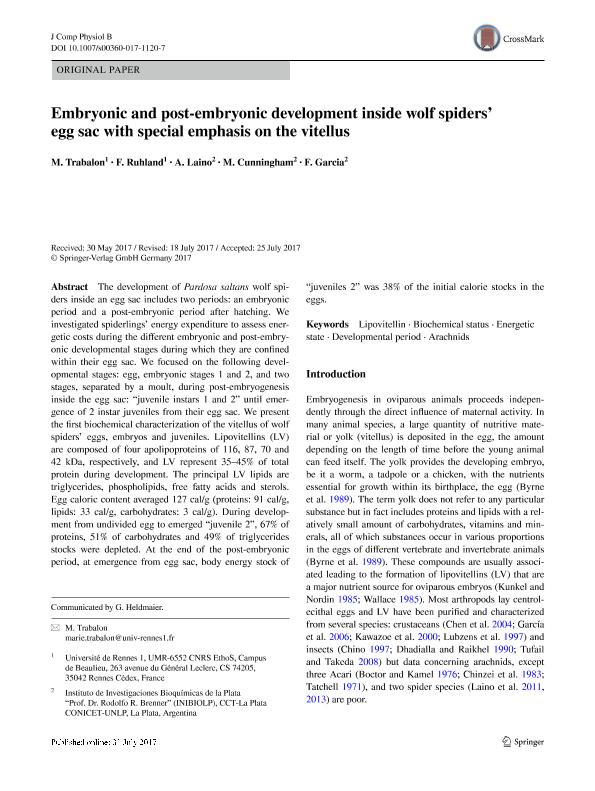Artículo
Embryonic and post-embryonic development inside wolf spiders’ egg sac with special emphasis on the vitellus
Fecha de publicación:
03/2018
Editorial:
Springer Heidelberg
Revista:
Journal of Comparative Physiology B: Biochemical, Systems and Environmental Physiology
ISSN:
0174-1578
Idioma:
Inglés
Tipo de recurso:
Artículo publicado
Clasificación temática:
Resumen
The development of Pardosa saltans wolf spiders inside an egg sac includes two periods: an embryonic period and a post-embryonic period after hatching. We investigated spiderlings’ energy expenditure to assess energetic costs during the different embryonic and post-embryonic developmental stages during which they are confined within their egg sac. We focused on the following developmental stages: egg, embryonic stages 1 and 2, and two stages, separated by a moult, during post-embryogenesis inside the egg sac: “juvenile instars 1 and 2” until emergence of 2 instar juveniles from their egg sac. We present the first biochemical characterization of the vitellus of wolf spiders’ eggs, embryos and juveniles. Lipovitellins (LV) are composed of four apolipoproteins of 116, 87, 70 and 42 kDa, respectively, and LV represent 35–45% of total protein during development. The principal LV lipids are triglycerides, phospholipids, free fatty acids and sterols. Egg caloric content averaged 127 cal/g (proteins: 91 cal/g, lipids: 33 cal/g, carbohydrates: 3 cal/g). During development from undivided egg to emerged “juvenile 2”, 67% of proteins, 51% of carbohydrates and 49% of triglycerides stocks were depleted. At the end of the post-embryonic period, at emergence from egg sac, body energy stock of “juveniles 2” was 38% of the initial calorie stocks in the eggs.
Archivos asociados
Licencia
Identificadores
Colecciones
Articulos(INIBIOLP)
Articulos de INST.DE INVEST.BIOQUIMICAS DE LA PLATA
Articulos de INST.DE INVEST.BIOQUIMICAS DE LA PLATA
Citación
Trabalon, M.; Ruhland, F.; Laino, Aldana; Cunningham, Monica Liliana; Garcia, Carlos Fernando; Embryonic and post-embryonic development inside wolf spiders’ egg sac with special emphasis on the vitellus; Springer Heidelberg; Journal of Comparative Physiology B: Biochemical, Systems and Environmental Physiology; 188; 2; 3-2018; 211-224
Compartir
Altmétricas




